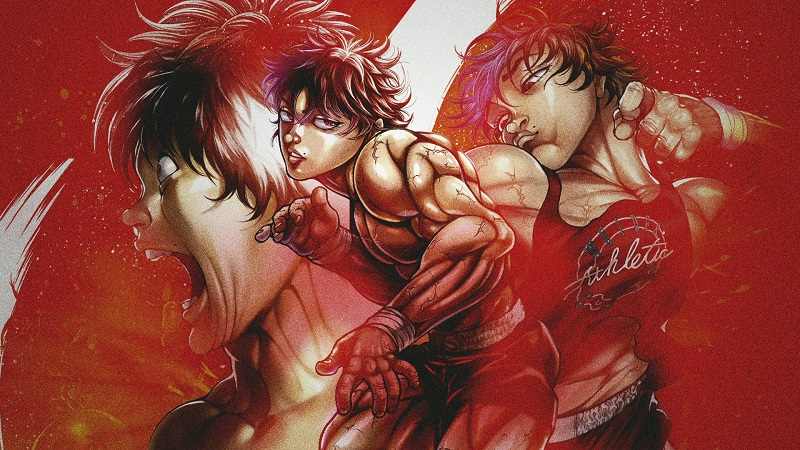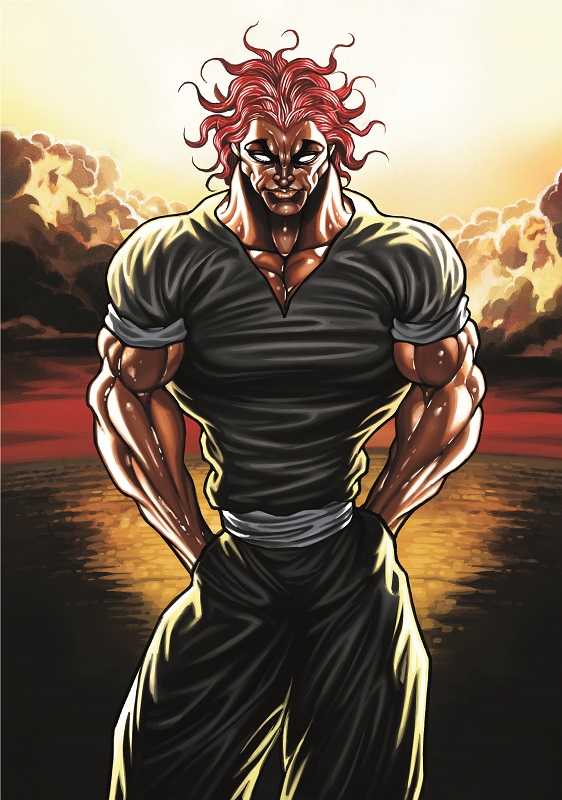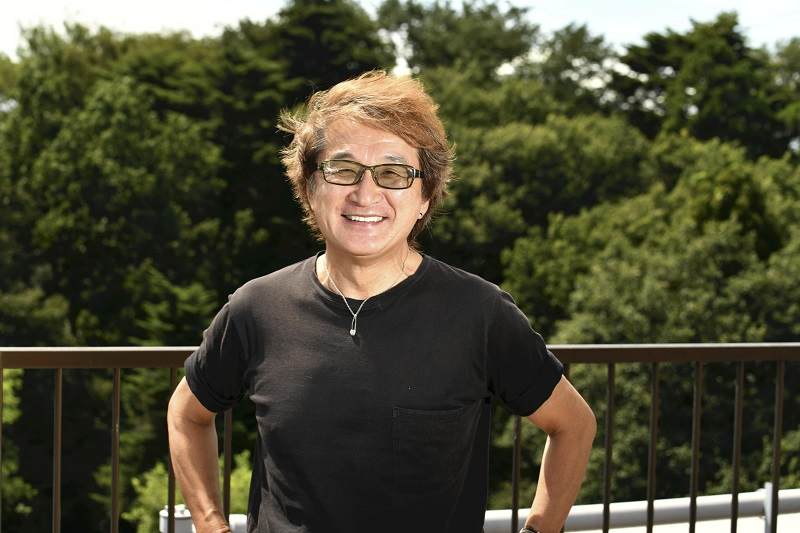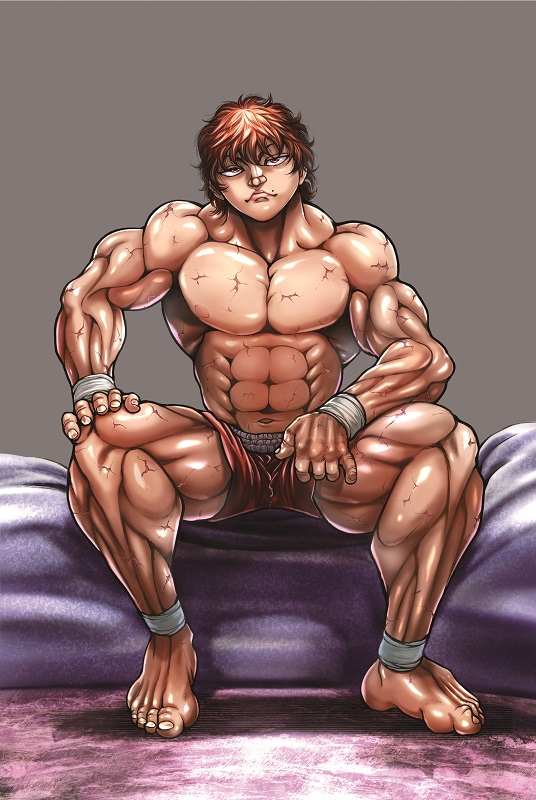
Baki Hanma
13:21 JST, October 25, 2021
Whether in an underground arena, on a street filled with onlookers, or during a classroom lesson, Baki fights without rules or taboos. The “Grappler Baki” (Baki the Grappler) manga series, which features an array of mixed martial arts fighters from around the world, is celebrating the 30th anniversary of its publication.
From its beginnings in 1991, the series has continued to excite readers with just a simple theme: Who is the ultimate fighter? Let’s take an in-depth look at the world represented by Baki through interviews with the manga’s author Keisuke Itagaki and its protagonist Baki Hanma himself.

Yujiro Hanma, Baki’s father
Symbol of strength
“I waver quite a bit along the way in making any decision, but it’s turned out these decisions were not wrong. That’s something I’d like to give myself credit for,” Itagaki said, looking back on the past 30 years.
Serialization of “Grappler Baki” started in the Shukan Shonen Champion magazine and has been followed by sequels, including “Baki” and “Baki Hanma.” The fifth and the latest series, “Bakidou,” features sumo wrestlers. About 85 million books have been printed across the entire Baki series.
The overarching story follows Baki, a young, undefeated underground fighter, as he comes to blows with various types of mixed martial arts fighters while striving to surpass his father, who’s known as “the mightiest being on Earth.”
Itagaki said that the decision to bring Baki’s father into the story came at the suggestion of an editor.
“My first editor for this project proposed the idea of Baki ‘awaiting someone’ while he defended his champion title. That someone could be a rival, a brother or a father. There were several options to choose from, but I found the father to be the easiest to depict,” he said.
Baki’s father, Yujiro, symbolizes power. His physical strength is so powerful that it could defeat the military of a major nation. The character is a reflection of Itagaki’s own fantasy of a father figure.
“It’s really nice to be able to look up to one’s father. My father was a completely different type of person, and I used to adore [the idea of] a father whom I would never be able to beat no matter what,” Itagaki said.

Keisuke Itagaki
More pain, more gain
Born in Hokkaido in 1957, Itagaki worked in a hotel after a stint as a Ground Self-Defence Force member before finally entering the world of manga through a mangaka training course organized by story writer Kazuo Koike. His debut work “Make-Upper” was published in 1989.
The creation of all the colorful characters in the Baki series, including the mighty father-son duo, stems from the characterization theory Itagaki learned in Koike’s course.
“Master Koike would often say, ‘You can easily make characters stand out by utilizing gossip.’ When you see someone extraordinary, you can’t help saying, ‘You won’t believe the amazing person I saw today.’ Those sorts of characters with outrageously great qualities make those around them feel the urge to tell others. That’s how a character should be in my opinion,” Itagaki said.
He now feels as if the characters have overtaken his intentions for them and have begun moving of their own accord.
“All I have to do is to listen to [the voices of] the characters. I think the reason I’ve been able to continue for 30 years is that the characters stand out,” Itagaki said.
And, of course, when speaking of the Baki series, one can’t fail to mention the ferocious fight scenes featuring brawlers boasting toned bodies and V-shaped torsos. The realism expressed in those scenes has won over so many fans because they are based on Itagaki’s own experiences in fighting sports. During his high school days, he took up Shorinji Kempo, a martial art, and later participated in the National Sports Festival as a boxer.
“A good thing about fight scenes is that you can enjoy the pain without experiencing it yourself. The more painful they look, the better they get,” he said.
The portrayals of men’s bodies pushed to the limit not only evoke the sensation of pain but also arouses ecstatic sensations.
“When you see a body that is bent to the extreme or twisted to its limit, you also want to see the moment the muscles are released from all that tension. Giving in to that impulse is important. This is something I learned from manga created by Hiroshi Motomiya,” Itagaki said.
Continuing to buck expectations
Another underlying theme in the series is the questioning of the definition of strength. The conclusion that Itagaki has come to is that it is “the willpower needed to selfishly maintain one’s own way,” an idea that penetrates the entire series.
“Strength is the ability to stay true to one’s will and ego [by any means]. On its own, that is neither a good or a bad thing. It’s a belief I’ve carried with me for more than 15 years,” Itagaki said.
Peppered among the manga’s fierce fights are contrastingly comical scenes, which is yet another of this popular series’ many charms. There are those who even insist the series is a comedy. When asked his take on the matter, Itagaki had this to say:
“When you describe something outrageous, you sometimes describe it as ‘almost laughable.’ There are views that ‘Baki’ is a comedy disguised as a fighter manga, which means that I’ve been able to depict greatness that elicits laughter. Being able to reach such a point makes me so happy.”
Having worked as a mangaka for more than three decades, he is now considered a veteran in the industry. While new talents are cropping up one after another, he keeps producing work that stands at the forefront of the manga scene.
“My strength lies in the experience I’ve gained over time without ever losing my passion,” he said, explaining his drive to go on.
With the latest story development becoming all the more compelling, including the father-son relationship between Baki and Yujiro, the series is more gripping than ever.
“Living up to the readers’ expectations while also going against [their predictions] is difficult. At the same time, I guess that’s also what makes it interesting. I’ll continue to predict what comes next by keeping a close eye on the world [of Baki]. I don’t think I can change the way I do things at this point. I’d like to go on writing against what [the readers] might expect,” he said.

Baki Hanma
A one-on-one interview with Baki Hanma
Baki Hanma is the youngest secret underground fighting champion. Even though stalwarts from around the world want to take him on, he only desires to get stronger in the hopes of besting his father.
The following is an “interview” with Baki Hanma, protagonist of the “Baki” series.
Q: What does it feel like to be the strongest person in the world?
Baki: I never dreamed of becoming “the world’s strongest.” I’d be happy with just being a bit stronger than my dad, Yujiro Hanma. That’s the goal I’m aiming for when it comes to martial arts and overall strength. It’s a commonplace issue in every family, so it’s not something I can be particularly proud of.
Q: Yujiro is the mightiest being on Earth.
Baki: While that does sound too mythical, the very thing that makes him who he is is his presence, which makes you wonder “just what would he do in a crisis like this?”
Q: I’m curious as to what happened after the temporary truce in your father-son quarrel.
Baki: It’s not a matter of who wins and who loses. I do take action when need be. It’s a family issue, so it’s a matter of course, I guess.
Q: Some people say the relationships between fighters in the underground arena are like those depicted in BL (boys’ love), a genre of homoerotic manga and novels.
Baki: When you say our relationships are like love affairs, you are spot on. In a romantic relationship, you’re able to keep going because love [victory] isn’t something you can grasp. Encounters with good rivals break up and help fill the boring and helpless days.
Q: It seems quite challenging to have everything in your life be about fighting.
Baki: When you work your body and soul, they are healed in the process. The place, time and rules don’t matter. From here, everything has already begun. That’s the real fight, I say.
"Culture" POPULAR ARTICLE
-

Van Cleef & Arpels Dazzles with Art Deco Artisanry at Tokyo Exhibit
-

Disney’s ‘Twisted-Wonderland’ Animated Series Puts Villains in Spotlight: New Show Features School Inspired by Classic Disney Films
-

Japan Plans to Distribute Manga Overseas Via New Platform
-

Japanese Craftsman Produces Beautiful and Durable Bags Made of Wood
-

Ayumi Hamasaki’s Shanghai Concert Canceled Day Before Schedule as Part of Beijing Backlash
JN ACCESS RANKING
-

Keidanren Chairman Yoshinobu Tsutsui Visits Kashiwazaki-Kariwa Nuclear Power Plant; Inspects New Emergency Safety System
-

Imports of Rare Earths from China Facing Delays, May Be Caused by Deterioration of Japan-China Relations
-

University of Tokyo Professor Discusses Japanese Economic Security in Interview Ahead of Forum
-

Japan Pulls out of Vietnam Nuclear Project, Complicating Hanoi’s Power Plans
-

Govt Aims to Expand NISA Program Lineup, Abolish Age Restriction




◎上海の日本アニメイベント_20251129YGTGS000921_C-250x168.jpg)




















